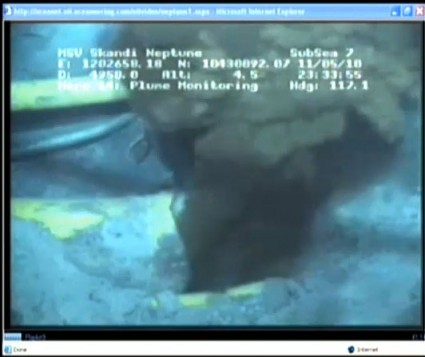Cross-posted from Wonk Room.
Officials have finally admitted that the Deepwater Horizon blowout is the worst oil disaster in American history, exceeding the Exxon Valdez spill. After a month of insisting that the damaged well was only spewing 210,000 gallons (5000 barrels) of oil a day into the Gulf of Mexico, officials admitted this morning that was a gross underestimate. In a conference call, Dr. Marcia McNutt, U.S. Geological Survey Director and chair of the technical group convened to determine the flow rate, announced that the Deepwater Horizon disaster has now spewed between 15 and 40 million gallons of oil into the Gulf of Mexico, greater than the estimated 11-million-gallon Exxon Valdez disaster.
McNutt explained that the flow rate group used multiple kinds of analysis: satellite imagery, mass balance analysis, and undersea video. McNutt expressed her greatest confidence in the mass balance analysis which estimated the flow rate over the first 27 days of the disaster at between 462,000 and 800,000 gallons (11,000 to 19,000 barrels) of oil a day. The video analysis team estimated an upper bound of one million gallons of oil a day. When asked if this spill exceed the Exxon Valdez disaster, McNutt replied, “You can do the math.”
A week and a half ago, McNutt said, officials were able to directly measure the composition of the plumes coming from the leak points. They found that 75 percent of the plumes were in fact natural gas, and only 25 percent oil, which is why outside video analysis that did not use that figure was so much higher.
If the top-kill efforts are unsuccessful and the gusher continues for the two months before the relief wells are estimated to work, the ultimate amount of oil spilled could be greater than 100 million gallons.
Throughout the course of the disaster, BP and administration officials made false claims about the scope of the disaster and the importance of finding out the flow rate, despite far different estimates from outside experts. As late as this week, National Oceanic and Atmospheric administrator Jane Lubchenco continued to insist the laughably low-ball number used since April 28 was the “best estimate.”
Update: More explanation of the mass balance analysis:
A mass-balance team made its estimate based upon the volume of oil seen on the surface of the water, saying that it believed 130,000-270,000 bbl [5.5 million to 11.3 million gallons] of oil was on the surface on May 17. Using that estimate along with calculations of oil already burned, skimmed, dispersed, or evaporated, the team calculated a flow rate estimate of 12,000-19,000 b/d [500,000 to 800,000 gallons per day].


